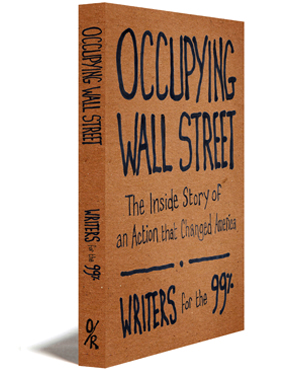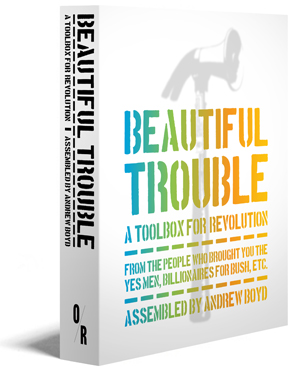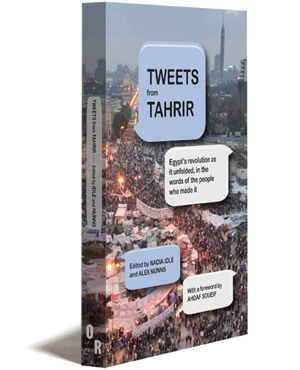Occupying Wall Street
The Inside Story of an Action that Changed America
WRITERS FOR THE 99%
"I'm awfully glad these writers were taking notes and recording this history as it happened—OWS is one of the most important developments in this country in many a year, and we need to understand how it happened and where it might go. This volume goes a long way toward filling that need!" —Bill McKibben
"An essential and galvanizing on-the-ground account of how oxygen suddenly and miraculously flooded back into the American brain." —Jonathan Lethem
"The last thirty years belonged to Wall Street. If Occupy gets it right, the next thirty should belong to us. This indispensable book is the first chapter in the story about the long revolution to come." —Andrew Ross
“The emphasis will be on everyday details of the occupation—a recreation of texture, in all its unfiltered smells and brain-bursting sounds.” —The Daily Beast
TweetBuy This Book
|
Paperback: $15/£10
|
E-book: $10/£7
|
Print + E-book: $20/£14
|
About the Book
For two months this fall, Zuccotti Park, squeezed deep in a canyon between bankers’ skyscrapers in lower Manhattan, was the site of an extraordinary political action. Home to the hundreds of anti-capitalist protestors who camped there overnight, and the thousands who visited to join the protest, the park became a magical place: a communion of sharing and consensus in the heart of a citadel defined by greed and oligarchy.
In the early hours of Tuesday November the 15th the occupiers’ camp was destroyed when police swept suddenly into the square, tearing down the tents, library, kitchen and medical center, and arresting hundreds. For the multitude supporting the action it was a heart-rending moment. But if the occupation at Zuccotti was destroyed that night, the movement it spawned across America has only just begun. Issues of equality and democracy, absent from mainstream political discussion in the United States for decades, are today springing up everywhere.
Now, in a new book assembled by a group of writers active in support of the occupation, the story of Occupy Wall Street is being told. Occupying Wall Street draws on extensive interviews with those who took part in the action to bring an authentic, inside-the-square history to life. In these pages you will discover in rich detail how the protest was devised and planned, how its daily needs were met, and how it won overwhelming support across the nation.
In a vivid, fast-paced narrative, the key events of the occupation are described: the pepper spraying of young women corralled between plastic fences by the NYPD; the mass arrests on the Brooklyn Bridge; the victory on October 14th when an announced “clean up” of the square was abandoned by a mayor’s office fearful of a PR disaster; and the eventual storming of the occupation that brought it to an abrupt end. Woven throughout are stories of daily life in the square focusing on how the kitchen, library, media center, clean-up, hospital, and decision-making at the General Assembly functioned, all in the words of the people who were there.
The future course of Occupy Wall Street remains unclear. But one thing is starkly evident: Under the banner “We are the 99%” the protest has given birth to America’s most important progressive movement since the civil rights marches half a century ago. This is the story of that beginning.
Writers for the 99% is a group of writers and researchers, active in supporting Occupy Wall Street, who came together to create this book. A list of all those contributing will appear at the back of the book.
All profits from this book will be donated to Occupy Wall Street.
Publication February 2nd 2012 • 200 pages b/w illustration throughout
paperback ISBN 978-1-935928-68-3 • ebook ISBN 978-1-935928-64-5
In the Media
Domus Italy, May 21st 2012
The Economist, April 7th 2012
Good, February 19th 2012
Socialist Review, February 15th 2012
The Huffington Post, February 1st 2012
Electric Literature, February 9th 2012
Nerve Magazine, January 30th 2012
The Guardian, January 25th 2012
Philosophy Football, January 24th 2012
The Telegraph, January 6th 2012
The New Yorker, January 2nd 2012
Counterpunch, December 23rd 2011
The Daily Beast, November 17th 2011
MSNBC – PowerWall, October 29th 2011
Galleycat, October 28th 2011
Good, October 27th 2011
Lit Reactor, October 27th 2011
Washington Post – Political Bookworm blog, October 27th 2011
The Millions, October 27th 2011
LIS News, October 26th 2011
Death and Taxes, October 26th 2011
Christian Science Monitor, October 26th 2011
Huffington Post, October 25th 2011
Village Voice, October 25th 2011
New York magazine, October 25th 2011
Read an Excerpt
The Kitchen
If the Zuccotti Park encampment was “semireligious,” as Rolling Stone magazine said that many in the park described it—and “a spiritual insurrection,” according to Adbusters editor Micah White, then one of the occupiers’ most holy acts was visiting the kitchen to get breakfast, lunch or dinner.
Heather Squire found her calling among the pizza boxes, the peanut butter and jelly, and the lines of OWS sleepers and day trippers, hands outstretched, waiting to be dished up a meal. Arriving at Zuccotti for the first time on October 1, Squire, 31 years old and with a BA in sociology, said she’d spent the four years since graduation filling out applications for entry level jobs sometimes directly, but more often only vaguely, related to her degree. She’d gotten nothing, and her most recent job had been as a $150aweek deliverer of sandwiches. In the park she recalled that she knew a lot about food: since age 14, she’d worked in restaurants, as a server and in the kitchen. She joined the OWS Kitchen Working Group.
The kitchen lay in the park’s center, and in its first weeks it stayed open 24/7, stocked with a glorious hodgepodge of donated food. A middleaged woman from the Bronx brought a hefty pot of chili. “My husband’s in the Transport Workers Union,” she said, as though no further explanation was necessary. Oth ers dropped by with fruit, bagels, cookies, hummus, casseroles. Responding to a list of nearby restaurants that delivered, posted on OWS’s Web site, the world used its credit cards to purchase takeout for the occupiers. The owner of Liberato’s Pizza, near Wall Street, told the New York Times he’d received orders from all over the U.S. and from Germany, France, England, Italy and Greece. The Kitchen Working Group’s Twitter account buzzed with exclamation marks and thank yous. “Fresh picked apples from Vermont!” enthused one tweet. “Shout out to Nancy in New Mexico for ordering us crazy good food from Katz’s Deli!”
In those early days, according to Heather, kitchen workers mostly opened boxes and washed dishes. But the impromptu nature of donations and deliveries made things touch and go. “WE NEED LUNCH!” one Kitchen Working Group tweet entreated. “SEND #OCCUPYWALLSTREET food!” WE’RE HUNGRY!” The occupation began giving the kitchen a budget of up to $1,500 a day for supplementary catering. Some volun teers started cooking in their own, small apartment kitchens. This was necessary because park rules forbade the use of flames to prepare food, and electrical power in Zuccotti was severely restricted.
Farmers helped the Kitchen Working Group to expand its menus. By October, fresh produce was being delivered in trucks dispatched from upstate New York, Western Massachusetts, and Vermont. Small, organic farms and distributors with names like Food Works, Littlewood, and Six Circles were banding together to send harvest to OWS and to the occupation in Boston. They organized a group and named it “Feed the Movement.” Emily CurtisMurphy, of Fair Food Farms in East Calais, Vermont, made a video for Feed the Movement’s blog, saying, “Some thing’s got to change,” a sentiment felt by many of the farmers providing food to OWS. One of Emily’s concerns was that “All this consolidation of wealth isn’t doing anything to create jobs for people in the rural economy.”
The Zuccotti kitchen staff could slice and dice some farm donations—cucumbers, lettuce, carrots—and make cold salads on site. But Heather wanted to cook the squash, grain and meat, and to use the dairy products without worrying about spoilage. If the kitchen could cook this food, OWS could reduce cater ing costs and use the savings to reimburse the farmers. Heather began looking for a commercial kitchen with cold and hot stor age. Out of the blue, a man named Leo Karl showed up at the information desk.
Leo is pastor of an evangelical church and director of Liber ty Café, a soup kitchen in East New York, a poor neighborhood in Brooklyn. Every weekday morning, Liberty Café cooks nutri tious, savory lunches for hundreds of poor diners. Leo volun teered to make available the café’s huge, wellequipped kitchen in the afternoon, so that OWS could prepare dinner.
Using Liberty Café’s facilities, OWS began cooking enor mous quantities of food—enough to feed dinner to at least 1,500 people on weekdays, and 3,000 on weekends. The Sustainability Committee helped out with developing a dish washing system, so as to avoid the waste of using disposable plates. The same committee organized a system for getting rid of kitchen scraps, as Brennan Cavanaugh, one of its founders, explained: “With the amount of food that was coming in and the donations and the amount of food being prepared, there was a lot of food waste. It was actually my wife, Catherine’s idea to start creating compost buckets and start taking it out. Then it was my idea to start doing it on bicycles.”
Cavanaugh and company were soon collaborating with bike activists to form a bike brigade to remove compost. “We have two pickups a day, fourteen a week. Yesterday, we pulled out seven fivegallon buckets of food waste. And we figure those buckets weigh anything from 30 to 35 pounds each. So seven buckets is over two 200 pounds taken out a day.” The groups would bring food waste from Zuccotti to community gardens in the Lower East Side, including El Jardin Paraiso, Belinda M’Finda Kalunga Community Garden, La Plaza Cultural, the Lower East Side Ecology Center, and a compost farm called Earth Matter, on Staten Island. “They just make compost and they have chickens. They are a living farm. They come in on their own bike. And they pick up twice a week.”
Pedal power was also used to provide electricity for the kitchen, as well as for the rest of the park. “One of the first things we realized we had to do was to get everybody here off of fossil fuels. So we made an energy bike,” noted Keegan, of the Sustainability Committee. “Now we can pedal to power a deep cycle battery . . . We started powering some of the things this occupation needs like laptops, cell phones, and cameras. As soon as we plugged it in all the other committees approached us and said we need one too.”
Serious foodies were at this point becoming involved in the kitchen. One was Eric Smith, a former chef at Manhattan’s Mid town Sheraton hotel. Eric had been laid off, and he volunteered his culinary skills to OWS, as well as his experience cooking for very large groups. Erin Littlestar, meanwhile, had been prepar ing to be a chef but changed her plans. She told The Huffing- ton Post she’d been scheduled to matriculate at the National Gourmet Institute, but never showed up to start classes after she spent a day in Zuccotti. “I just got this feeling like there was something bigger I was supposed to be doing than just going to school to learn chiffonade,” Erin said.
The New York Post, with typically snide hostility, ran a front page on a “typical” Occupy dinner, prepared in Brooklyn: organic chicken soup with root vegetables, parsley, rosemary and thyme; salad made with sheep’smilk cheese and chimi churri sauce with a dash of garlic; spaghetti; brown rice; beans; and for dessert nuts and banana chips donated by a coop in Ithaca.
Mocking the menu as snobbish, the Post overlooked two things. For one, the Brooklyn soup kitchen was serving poor people food similar to the OWS menu. And back at Zuccotti, OWS fare went not just to those longfamiliar with goat cheese. The kitchen was feeding many far less affluent people. Including the homeless.
By late October, the kitchen working group was feeling overwhelmed by how poorly organized they were relative to the immense job they faced every day. Among the difficulties: a second prep kitchen had opened in Brooklyn, but assigned driv ers sometimes didn’t show up at either kitchen, so the food sat and spoiled. Heather, and other Kitchen Work Group members, wanted desperately to regroup and fix things.
In late October they decided to take a threeday break to re flect and reorganize during which time they would serve the oc cupiers only “simplified meals” such as peanut butter and jelly sandwiches. But the kitchen’s difficulties got mixed with other problems. Some sexual assaults had occurred in Zuccotti. Drug and alcohol use was becoming more widespread. The Peace Council conferred with Kitchen, suggesting they serve meals for only two hours instead of round the clock, “to discourage peo ple from coming to the camp all fucked up,” Heather recalled. When the Kitchen Working Group announced its “simplified” meal plan, on October 27, all hell broke loose. Failing to under stand the group’s organizational problems, occupiers accused it of trying to starve out the homeless. “People started freaking out,” Heather reported. “There was almost violence.”
In the end, meal times were restricted, and diners had to stand in a long, snaking line to get their food. After the three day “simplification,” the food returned to being as tasty and healthful as ever. And everyone ate.
At around 4 o’clock in the morning on November 15, Heather and two coworkers locked arms and sat down on the ground in a puddle of mustard and vinegar that had spilled from bottles smashed by the NYPD during that night’s eviction. They had spent their time at the occupation cooking, serving, and washing dishes, then cooking, serving, and washing some more. They were heroes of the kitchen, and perhaps appropriately, the last people in the park to be arrested.







